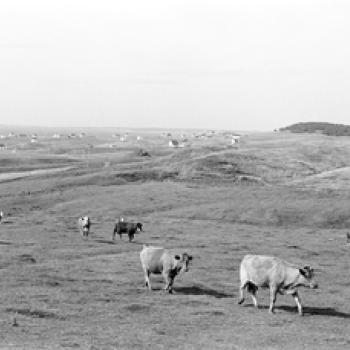What If We Changed the Book? Problem-Posing with Sixteen Cows

- Preview |
- Standards |
- Resources & Preparation |
- Instructional Plan |
- Related Resources |
- Comments
Overview
A piece of math-related children's literature, Sixteen Cows, is used to demonstrate the strategy of problem-posing. After hearing the story read aloud, students are invited to brainstorm some literary and mathematical observations to the story. With the teacher's guidance, students then turn those observations into "what-if" mathematical extensions. These extensions become mathematical problems that students solve, both individually and as a whole class. Since this strategy highlights changing attributes of a story, it underscores for children the range of choices that authors have.
Featured Resources
- Problem Posing with Sixteen Cows: This chart illustrates several possible math extensions for Sixteen Cows.
- Good Books for Problem-Posing Extensions: This book list includes math-related children’s literature that would work well with the problem-posing strategy.
From Theory to Practice
Problem-posing involves taking a "what-if" stance toward a problem, situation, or story. It consists of describing, modifying and extending the attributes of a story. As children list these attributes, they see a world of related stories embedded within the first story (Whitin & Whitin, 2004). It has been argued that the more learners change a given story/problem, the better they understand it (Brown & Walter, 2005). As children have the opportunity to discuss their observations with peers, they are better able to write about the relationships that they see in the story (Short & Harste, 1996). Sorting through mathematical attributes supports children "to analyze situations carefully in mathematical terms and to pose problems based on situations they see" (NCTM, 2000, p. 19). In this lesson, children note the attributes of a story and use these as the basis for their own mathematical extensions.
Further Reading
Common Core Standards
This resource has been aligned to the Common Core State Standards for states in which they have been adopted. If a state does not appear in the drop-down, CCSS alignments are forthcoming.
State Standards
This lesson has been aligned to standards in the following states. If a state does not appear in the drop-down, standard alignments are not currently available for that state.
NCTE/IRA National Standards for the English Language Arts
- 1. Students read a wide range of print and nonprint texts to build an understanding of texts, of themselves, and of the cultures of the United States and the world; to acquire new information; to respond to the needs and demands of society and the workplace; and for personal fulfillment. Among these texts are fiction and nonfiction, classic and contemporary works.
- 5. Students employ a wide range of strategies as they write and use different writing process elements appropriately to communicate with different audiences for a variety of purposes.
- 6. Students apply knowledge of language structure, language conventions (e.g., spelling and punctuation), media techniques, figurative language, and genre to create, critique, and discuss print and nonprint texts.
- 11. Students participate as knowledgeable, reflective, creative, and critical members of a variety of literacy communities.
- 12. Students use spoken, written, and visual language to accomplish their own purposes (e.g., for learning, enjoyment, persuasion, and the exchange of information).
Materials and Technology
- Sixteen Cows by Lisa Wheeler or another selected book for problem posing
- Problem Posing with Sixteen Cows
- Teacher Talk for Problem-Posing Extensions
Printouts
Preparation
- Select and acquire problem-posing book to read to the class. This lesson uses the book Sixteen Cows. See the booklist for other options.
- Review the chart of “what-if” extensions for Sixteen Cows so that you are familiar with some of the possible mathematical extensions.
- Review Teacher Talk handout for examples of guiding questions.
- Make copies of blank chart, chart of observations and extensions.
- Test the Comic Creator interactive, ReadWriteThink Printing Press, Stapleless Book interactive, and Multigenre Mapper on your computers to familiarize yourself with the tools and ensure that you have the Flash plug-in installed. You can download the plug-in from the technical support page.
Student Objectives
Students will:
- identify attributes of a story.
- pose a problem based on these attributes.
- use pictures, numbers and words to solve a mathematical extension of the story.
Session One
- Introduce Sixteen Cows to the class or other selected book for problem posing.
- Invite a few students to respond to each page as you read it aloud.
- After reading the story, invite the class to respond further by asking:
- What did you find interesting about this story?
- What else did you notice?
- As the students are responding to the story, fill in the chart with their observations.
- If the students do not mention some of the mathematical features of the story, then ask them to do so directly:
- What do you notice about the numbers in this story?
- How do the numbers change?
- What do you notice about the numbers in this story?
- Add these observations to the left hand side of the chart as well.
- Encourage many different answers, even though they may seem redundant. The language of each observation can offer different possibilities for extensions. Possible observations include the following:
- “Both numbers are 8.”
- “They each have the same number of cows.”
- “They each have an even number of cows.”
- “The cows didn’t look the same but the people each had 8.”
- “Both numbers are 8.”
- After the students have shared about 10 observations (including at least 6-7 mathematical ones) and they have been recorded, demonstrate how to create some problem extensions. If needed, follow the Teacher Talk handout for problem-posing examples.
- Brainstorm some possible “what-ifs” for four or five of the students’ observations.
- Decide on one “what-if” extension (based on the various abilities of your students) and ask each student to solve it, using pictures, numbers and words to explain their answer.
- After the children have had time to solve this problem, invite different children to share their solutions with the whole class.
- Emphasize the different ways that children used pictures, numbers and words in their explanations. For instance, you might say, “I appreciate how you used arrows to show how you added those numbers together” or “I appreciate how you used the word ‘double’ to explain what you did first.”
- Begin a class chart that lists effective ways that children use pictures, numbers and words to make their thinking visible.
Session Two
- Return to the chart of observations and “what-if” extensions.
- Read the list over together, emphasizing how the extensions were derived from the initial observations.
- Select two other problems to solve, and invite students to solve at least one of these. Again, encourage students to use pictures, numbers and words in their explanation.
- Provide another sharing time when the class can discuss the solutions as well as their different ways of representing their thinking.
- Invite students to revise and edit one of their solutions to publish. Some options are as a class book or bulletin board display on problem-posing. Some of their work might be included in a family newsletter as well.
Extensions
- Invite students to develop an alternative story that is based on some of their “what-if” extensions. The following alternative provides an example:
If there are now 4 people sharing 16 cows, how might this mathematical variation change the story line? What will be the central problem of this story? Will there now be two couples marrying at the end of the tale?
- Read other books that lend themselves to problem-posing extensions. Before reading the next book aloud to the children, you might create a chart yourself (or with other teachers) of your own observations and “what-if” extensions. In this way, you can envision more of the mathematical possibilities ahead of time; then, you can share the story with students and brainstorm together some observations and possible extensions.
- Extend your study of Sixteen Cows with the additional teaching ideas on the author's Website.
Student Assessment / Reflections
Feedback for this lesson should be ongoing, integrated with the students' problem-posing and problem-solving process. It's not something that occurs after the project is completed, but while students are working. Since the focus is on the strategies and processes students use, feedback and reflection takes the form of kidwatching and specific commentary that helps students expand and extend their language strategies. Use this information to create formal or informal checklists, which you can refer to as you observe students at work.
Whole group and small group participation
In your observations of student groups, these questions can guide your observations:
- Are students engaged in the group work?
- Do they listen to the suggestions of others?
- Do students work cooperatively together throughout the lesson?
- Do students provide useful ideas when participating in the group?
- Do the members actively look for solutions for one another’s problem-posing?
- Do students listen to, share with, and support the efforts of others?
Student explanations of their strategies
As you read or listen to students’ explanations, these questions can guide your observations:
- Are the pictures, numbers, and words clear?
- Do they add to the reader’s or listener’s understanding of the strategies?
- Does the explanation show a complete understanding of the mathematical concepts used to solve the problem?
Quality of story problem written extensions and individual student follow-up work, including clarity of ideas and details in written work
As you read students’ story problems, these questions can guide your observations:
- Is the problem and solution correct? creative?
- Is the solution easy-to-understand and logical?
- Are the details clear and complete?
- Does the story follow a clear sequence? Are the ideas clear and organized?
- Does the story problem include creative details and/or descriptions?
- Is the story is readable, clean, neat and attractive?


Add new comment